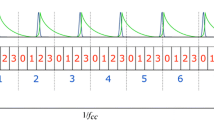Abstract
Tissue characterization by endoscopic fluorescence imaging of endogenous or exogenous fluorochromes is a promising method for early cancer detection. However, the steady-state fluorescence contrast between healthy tissue and lesions such as early-stage carcinomas is generally poor. The authors propose to improve this contrast by using the additional information contained in the fluorescence lifetime (FLT). The FLT of several fluorochromes is sensitive to their physico-chemical environment.
The FLT can be measured by frequency-domain methods. The excitation light from a continuous wave (CW) laser is modulated in amplitude at radio-frequencies by an electro-optic modulator, and delivered to the tissue via an optical fibre. The endoscopie site is imaged by an endoscope on to an optical device. The gain of the fluorescence image detector is also modulated at the same frequency for homodyning. The tissue fluorescence image is recorded at several phases between the excitation and the detection modulations during an acquisition cycle. With these images, an image processor calculates the apparent FLT for each pixel and constructs a lifetime image of the endoscopie site. This process is performed at quasi-video frequencies.
The influence of various physical parameters (modulation frequency, number of images by cycle, shot noise, tissue optical properties etc.) has been investigated by analytical analysis, simulation methods and experimentation.
Preliminary results obtained on human tissues are also presented to illustrate the potentiality of the method.
Similar content being viewed by others
References
Jichlinski P, Forrer M, Mizeret J et al. Usefulness of fluorescence photodetection of neoplastic urothelial foci in bladder cancer following intravesical instillation of delta-aminolevulinic acid (5-ALA). San Jose, CA, USA.SPIE 1996,2671:340–347
Lam S, Hung J, Palcic B. Detection of lung cancer by ratio fluorimetry with and without Photofrin II.Opt Fib Med V 1990:561–568
Schomacker KT, Frisoli JK, Compton CC et al. Ultraviolet laser-induced fluorescence of colonic tissues: basic biology and diagnostic potential.Lasers Surg Med 1992,12:63–78
Harries ML, Lam S, Macaulay C, Qu JA, Palcic B. Diagnostic-imaging of the larynx—autofluorescence of laryngeal tumors using the helium cadmium laser.J Laryngol Otol 1995,109:108–10
Wagnières G, Depeursinge C, Monnier P et al. Photodetection of early cancer by laser-induced fluorescence of a tumor selective dye: Apparatus design and realization.SPIE 1990,1203:43–52
Proflo AE. Laser excited fluorescence of hematoporphyrin derivative for diagnosis of cancer.IEEE J Quant Electronics 1984,CIO-20:1502–7
Profio AE, Balchum OJ, Lam S. Endoscopic fluorescence detection of early lung cancer. Optical methods for tumor treatment and early diagnosis: mechanisms and techniques.SPIE 1991,1426:44–6
Monnier P, Savary M, Fontolliet C et al. Photodetection and photodynamic therapy of ‘early’ squamous cell carcinomas of the pharynx, oesophagus and tracheo-bronchial tree.Lasers Med Sci 1990,5:149–69
Andersson-Engels S, Ankerst J, Montan S, Svanberg K. Aspects of tumour demarcation in rats by means of laser-induced fluorescence and haematoporphyrin derivatives.Lasers Med Sci 1988,3:239–47
Baumgartner R, Fisslinger H, Jocham D et al. A fluorescence imaging device for endoscopie detection of early stage cancer—instrumental and experimental studies.Photochem Photobiol 1987,46:759–63
Lam S, Hung J, Palcic B. Mechanism of detection of early lung cancer by ratio fluorimetry.Lasers Life Sci 1991,4:67–73
Sinaasappel M, Sterenborg HJCM. Quantification of the hematoporphyrin derivative by fluorescence measurement using dual-wavelength excitation and dual-wavelength detection.Appl Opt 1993,32:541–8
Pradhan A, Das BB, Yoo KM et al. Time-resolved UV photoexcited fluorescence kinetics from malignant and non-malignant human breast tissues.Lasers Life Sci 1992,4:225–34
Schneckenburger H, Seidlitz HK, Eberz J. New trends in photobiology—Time-resolved fluorescence in photobiology.J Photochem Photobiol B: Biol 1988,2:1–19
Lakowicz JR, Szmacinski H, Nowaczyk K, Johnson ML. Fluorescence lifetime imaging of free and proteinbound NADH.Biochemistry 1992,89:1271–5
Schneckenburger H, König K., Kunzi-Rapp K, Westphal-Frösch C., Ruck A. Time-resolved in-vivo fluorescence of photosensitizing porphyrins.J Photochem Photobiol B: Biol 1993,21:143–7
Wagnières G, Iinuma S, Schomacker KT, Deutsch T, Hasan T. In-vivo tissue characterization using environmentally sensitive fluorochromes.Fluoresc Microsc Fluoresc Probes 1996:203–209
Zhang JZ, O’Neil RH, Evans JE. Femtosecond studies of hematoporphyrin derivative in solution: effect of pH and solvent on the excited state dynamics.Photochem Photobiol 1994,60:301–9
Lakowicz JR, Szmacinski H, Nowaczyk K, Berndt KW, Johnson ML. Fluorescence lifetime imaging.Anal Biochem 1992,202:316–30
Wagnières G, Mizeret J, Studzinski A, van den Bergh H. Endoscopie frequency-domain fluorescence lifetime imaging for clinical cancer photodetection: apparatus design. In: Dougherty TJ (ed.)Optical Methods for Tumor Treatment and Detection: Mechanisms and Techniques in PDTIV. San Jose.SPIE 1995, 2392:42–54
Lakowicz JR.Principles of Fluorescence Microscopy. New York: Plenum Press, 1983
Jameson DM, Gratton E, Hall R. The measurement and analysis of heterogeneous emission by multifrequency phase and modulation fluorometry.Appl Spectrosc Rev 1984,20:55–106
Mizeret J, Wagnières G, Studzinski A, Shangguan C, van den Bergh H. Endoscopie tissue fluorescence life-time imaging by frequency-domain light induced fluorescence.Optical biopsies. Barcelona, Spain.SPIE 1995, 2627:40–8
MacAdam DL.Color Measurement. Berlin: Springer-Verlag, 1985
Kowaliski P.Vision de la Couleur. Paris: Masson, 1990
Wang L, Jacques S-L. Monte-Carlo Modeling of Light Transport in Multilayered Tissues in Standard C. Houston: University of Texas, 1992
Author information
Authors and Affiliations
Rights and permissions
About this article
Cite this article
Mizeret, J., Wagnières, G., Stepinac, T. et al. Endoscopic tissue characterization by frequency-domain fluorescence lifetime imaging (FD-FLIM). Laser Med Sci 12, 209–217 (1997). https://doi.org/10.1007/BF02765101
Received:
Accepted:
Issue Date:
DOI: https://doi.org/10.1007/BF02765101




